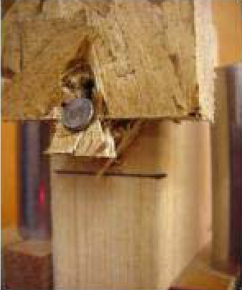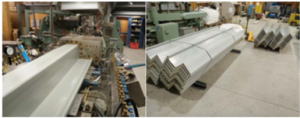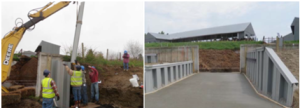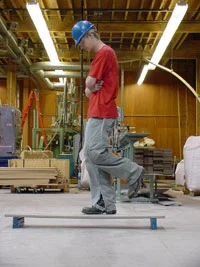Wave Rider – a low-maintanence off-shore wind resource assessment buoy
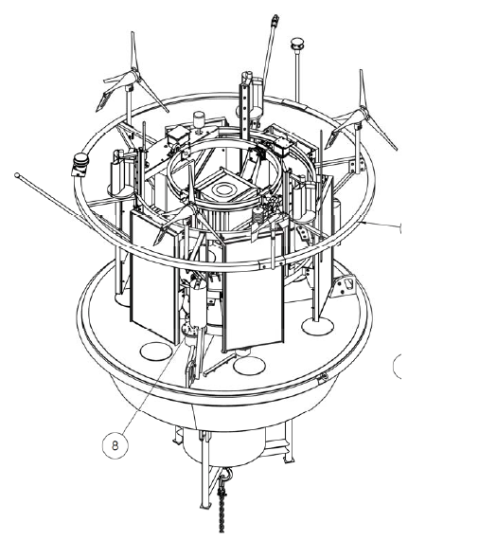 This buoy system has the capability of conducting long-term offshore wind resource assessment campaigns with limited maintenance. Read More…
This buoy system has the capability of conducting long-term offshore wind resource assessment campaigns with limited maintenance. Read More…
Reinforcement system increases wall panel strength by 20%
When stressed, oriented strand board (OSB) panels tend to fail along the edges and at nail sites, particularly if the panel has gotten wet. This technology presents a system for waterproofing and reinforcing panel edges. The reinforced edge improves fastener performance and reduces the edge swell and weakening caused by moisture exposure. Reinforced edges strengthen the panel by up to 20%.
UMaine Reference: 2005-07
Patents:
(US 6,699,575 issued Mar 2, 2004)
US 7,547,470 issued Jun 16, 2009
Inventors: Douglas J. Gardner, Stephen M. Shaler, Lech Muszynski, Ciprian Pirvu, Jungil Son
Composite Panels for Blast and Ballistic Protection

The Modular Ballistic Protection System (MBPS) provides soldiers with enhanced ballistic protection where it never existed before – in their tents where they work, eat, and sleep. The system consists of composite ballistic panels that are mounted to the inside of the tent frame using an energy-absorbing connection system. Requiring no tools, the MBPS can be used to up-armor a 20ft x 32ft tent in less than 30 minutes with 4 soldiers.
US Patent 7,68,5921
Bridge in a Backpack®

The Bridge-in-a-Backpack is a lightweight, corrosion resistant system for short to medium span bridge construction using FRP composite arch tubes that act as reinforcement and formwork for cast-in-place concrete. The arches are easily transportable, rapidly deployable and do not require the heavy equipment or large crews needed to handle the weight of traditional construction materials.
To date six Maine bridges have been built using the Bridge-in-a-Backpack technology. Several bridge projects are planned for 2012 throughout New England and beyond.
UMaine Tech ID 2005-14
US Patent Number 7,811,495
Additional US and International Patents Pending
Exclusively Licensed to Advanced Infrastructure Technologies
Netforms Pre-Fab Roofing Panels Reduce Construction and Heating Costs

PROBLEM: Insulated, ventilated roofs, particularly those covering open floor plans and cathedral ceilings, are difficult and expensive to build.
SOLUTION: These economical prefabricated panels incorporate wood I-joist framing, OSB sheathing, insulation and ventilation into a single product to be used in light-frame construction applications.
TECH ID: 2008-34
PATENT: US 8,046,969; US 8,141,313
LINK:
DEVELOPMENT PLAN: Undetermined. Has been successfully demonstrated, but on hold given the current downturn in construction.
New Composites Made from up to 60% Inexpensive, Raw Plant Material
PROBLEM: Composite manufacturers need ways to improve extruded thermoplastics using inexpensive, environmentally friendly ingredients and without slowing process time.
Low Maintainance Sheet Piling Reduces Life Cycle Costs of Retaining Walls
PROBLEM: Commonly available sheet piling used for retaining walls corrodes, increasing maintenance costs and reducing the useful life of the construction. These problems are heightened in a marine environment.
SOLUTION: Our patented wood composite sheet piling system does not corrode, which reduces overall life cycle costs. Additionally it is chemically inert and 100% recyclable.
COMpris: A New Method to Manufacture Stronger and Thicker Composites
A solution for simplifying manufacturing of utility-scale wind turbine blades?
PROBLEM: Manufacturers of large composite components such as boats or wind blades are currently limited to using non-recyclable materials and labor intensive manufacturing processes.
38% Stronger Reinforced Glulam Construction Beams

PROBLEM: Builders prefer reinforced glulam beams for applications benefiting from thier beauty or shape versatility. But glulam beams have a tendency to weaken (delaminate, or peel) on the ends when the center of the beam is bent or stressed.
SOLUTION: UMaine offers reinforced glulam beams that withstand end delamination under 38% more bending stress compared to other reinforced beams, and 95% more stress compared to non-reinforced beams.

